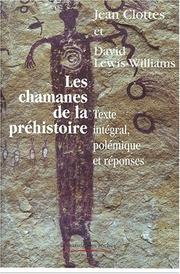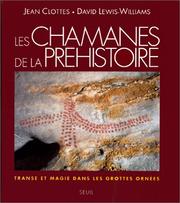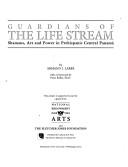| Listing 1 - 7 of 7 |
Sort by
|

ISBN: 2912691117 Year: 2001 Publisher: Paris : La Maison des Roches,
Abstract | Keywords | Export | Availability | Bookmark
 Loading...
Loading...Choose an application
- Reference Manager
- EndNote
- RefWorks (Direct export to RefWorks)
Cave paintings --- Petroglyphs --- Art, Prehistoric --- Art, Shamanistic --- Shamanism in art. --- Peintures rupestres --- Pétroglyphes --- Art préhistorique --- Art chamanique --- Chamanisme dans l'art --- Pétroglyphes --- Art préhistorique

ISBN: 2020289024 9782020289023 Year: 1996 Volume: *1 Publisher: Paris : Editions du Seuil,
Abstract | Keywords | Export | Availability | Bookmark
 Loading...
Loading...Choose an application
- Reference Manager
- EndNote
- RefWorks (Direct export to RefWorks)
Shamanism in art --- Shamanisme dans l'art --- Sjamanisme in de kunst --- Peinture rupestre --- Cave paintings --- Petroglyphs --- Art, Prehistoric --- Art, Shamanistic --- Peintures rupestres --- Pétroglyphes --- Art préhistorique --- Art chamanique --- Pétroglyphes --- Art préhistorique --- Rock paintings --- Europe --- Art [Prehistoric ] --- Art [Shamanistic ]

ISBN: 0963395939 Year: 1995 Publisher: Santa Ana, Calif. : [Seattle] : Cultural Arts Press, The Bowers Museum of Cultural Art ; Distributed by the University of Washington Press,
Abstract | Keywords | Export | Availability | Bookmark
 Loading...
Loading...Choose an application
- Reference Manager
- EndNote
- RefWorks (Direct export to RefWorks)
Indians of Central America --- Indian pottery --- Art, Shamanistic --- Indiens d'Amérique --- Céramique indienne d'Amérique --- Art chamanique --- Antiquities. --- Antiquités --- Panama --- Panamã --- Indiens d'Amérique --- Céramique indienne d'Amérique --- Antiquités --- Panamá
Book
ISBN: 9782757804087 2757804081 Year: 2007 Volume: 379 Publisher: Paris : Seuil,
Abstract | Keywords | Export | Availability | Bookmark
 Loading...
Loading...Choose an application
- Reference Manager
- EndNote
- RefWorks (Direct export to RefWorks)
Cave paintings --- Petroglyphs --- Art, Prehistoric --- Art, Shamanistic --- Peintures rupestres --- Pétroglyphes --- Art préhistorique --- Art chamanique --- Chamanisme --- --Préhistoire --- --Art --- --Paléolithique --- --Analysis. --- prehistorie --- sjamanen --- sjamanisme --- 7.031.1 --- Pétroglyphes --- Art préhistorique --- Art, Prehistoric - Analysis. --- Préhistoire --- Art --- Paléolithique

ISBN: 184171268X Year: 2001 Volume: 982 Publisher: Oxford, England : Archaeopress,
Abstract | Keywords | Export | Availability | Bookmark
 Loading...
Loading...Choose an application
- Reference Manager
- EndNote
- RefWorks (Direct export to RefWorks)
Indians of South America --- Shamanistic symbolism --- Art, Shamanistic --- Shamanism --- Grave goods --- Indiens d'Amérique --- Symbolisme chamanique --- Art chamanique --- Chamanisme --- Mobilier funéraire --- Funeral customs and rites --- Congresses. --- History --- Congresses --- Antiquities --- Rites et cérémonies funéraires --- Congrès --- Histoire --- Antiquités --- Indiens d'Amérique --- Mobilier funéraire --- Rites et cérémonies funéraires --- Congrès --- Antiquités
Book
ISBN: 9780292728769 9780292735439 029272876X 029273543X Year: 2012 Publisher: Austin, Tex. University of Texas Press
Abstract | Keywords | Export | Availability | Bookmark
 Loading...
Loading...Choose an application
- Reference Manager
- EndNote
- RefWorks (Direct export to RefWorks)
"Huichol Indian yarn paintings are one of the world's great indigenous arts, sold around the world and advertised as authentic records of dreams and visions of the shamans. Using glowing colored yarns, the Huichol Indians of Mexico paint the mystical symbols of their culture--the hallucinogenic peyote cactus, the blue deer-spirit who appears to the shamans as they croon their songs around the fire in all-night ceremonies deep in the Sierra Madre mountains, and the pilgrimages to sacred sites, high in the central Mexican desert of Wirikuta. Hope MacLean provides the first comprehensive study of Huichol yarn paintings, from their origins as sacred offerings to their transformation into commercial art. Drawing on twenty years of ethnographic fieldwork, she interviews Huichol artists who have innovated important themes and styles. She compares the artists' views with those of art dealers and government officials to show how yarn painters respond to market influences while still keeping their religious beliefs. Most innovative is her exploration of what it means to say a tourist art is based on dreams and visions of the shamans. She explains what visionary experience means in Huichol culture and discusses the influence of the hallucinogenic peyote cactus on the Huichol's remarkable use of color. She uncovers a deep structure of visionary experience, rooted in Huichol concepts of soul-energy, and shows how this remarkable conception may be linked to visionary experiences as described by other Uto-Aztecan and Meso-American cultures."--Publisher.
Ethnology. Cultural anthropology --- Applied arts. Arts and crafts --- Mexico: West --- Huichol art --- Art, Shamanistic. --- Hallucinogenic drugs and religious experience. --- Symbolism in art. --- Art huichol --- Art chamanique --- Hallucinogènes et expériences religieuses --- Symbolisme dans l'art --- Hallucinogènes et expériences religieuses --- Huichol mythology. --- Huichol textile fabrics. --- Huichol art. --- Allegory (Art) --- Signs and symbols in art --- Art --- Huichol Indians --- Textile fabrics, Huichol --- Textile fabrics --- Mythology, Huichol --- Art, Huichol --- Art, Mexican --- Experience (Religion) and hallucinogenic drugs --- Experience (Religion) --- Shamanistic art --- Shamanism --- Textile industry and fabrics


ISBN: 2850880787 9782850880780 Volume: 31 Publisher: Paris Citadelles & Mazenod
Abstract | Keywords | Export | Availability | Bookmark
 Loading...
Loading...Choose an application
- Reference Manager
- EndNote
- RefWorks (Direct export to RefWorks)
Cet ouvrage reprend l'art des peuples du Nord : - l'art Esquimau des Aléoutes d'Alaska, - l'art des Inuits répartis entre l'Alaska, le Canada, le Groenland et la Sibérie orientale , - l'art des Indiens sub-arctiques nord-américains (les Tlingit, les Haïda, les Tsimshian, les Wakashan du Nord, les Nuxalk, les Kwakwaka'wakw, les Nuuchab-nulth, les Salish de la côte), - l'art Athapascan du Nord, - l'art des Algonquins, - l'art des Sâmes ou Lapons du nord de la Scandinavie, - l'art des peuples du Nord-Sibérien distribués entre plusieurs ethnies (Nénètses, Khantes et Manses, Kètes, Bouriates, Evenks, Yakoutes/Iakoutes/Sakha, Tchouktches, Koriaks, Itelmènes, les Nivkbes et les Nanaïs), - l'art des Aïnous. Un chapitre important est consacré aux artistes du XXe siècle du Grand Nord.
Eskimo art --- Art, Shamanistic --- Arctic peoples --- Indian art --- Art inuit --- Art chamanique --- Peuples de l'Arctique --- Art indien d'Amérique --- Art --- Arctische bevolking --- Arctische volkeren --- Peuples arctiques --- Population arctique --- Indiens d'Amerique --- Algonquiens --- Amerique du Nord --- Groenland --- Sibérie --- ethnic art --- Greenland --- Siberia --- Arts primitifs --- Histoire de l'art --- Masque --- Sculpture --- Préhistoire --- 18e siècle --- 19e siècle --- 20e siècle --- Alaska --- Amérique du Nord --- Canada --- Scandinavie --- Ethnology. Cultural anthropology --- sculpture [visual works] --- masks [costume] --- costume [mode of fashion] --- North America --- Arctic regions --- Arts premiers --- Art lapon --- Art inuit - Alaska --- Indiens d'Amerique - Art - Groenland --- Indiens d'Amerique - Nord-Ouest, Cote (Amerique du Nord) - Art --- Algonquiens - Art --- Alaska [state]
| Listing 1 - 7 of 7 |
Sort by
|

 Search
Search Feedback
Feedback About UniCat
About UniCat  Help
Help News
News